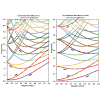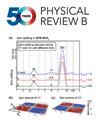量子点中的重空穴自旋弛豫:各向同性效应与各向异性效应
IF 3.7
2区 物理与天体物理
Q1 Physics and Astronomy
引用次数: 0
摘要
半导体量子点(QDs)单孔自旋中的非电荷逻辑可由各向异性栅极电位控制,这为制造下一代固态量子器件提供了概念。在本研究中,我们研究了各向同性和各向异性声子介导的量子点中重空穴自旋热点的自旋弛豫行为。众所周知,对于各向同性 QD 中的电子自旋,由于 Rashba 自旋轨道耦合,热点总是存在的。但对于各向同性点中的重空穴,我们发现自旋热点的出现对体积 g 因子很敏感。InAs和GaSb点中出现拉什巴自旋轨道耦合热点的原因是这些材料具有负的体g因子,而GaAs和InSb点中出现德雷斯豪斯自旋轨道耦合热点的原因是它们具有正的体g因子。另一方面,对于各向异性的 QDs,由于其平面内旋转对称性被打破,自旋热点普遍存在。此外,增强拉什巴耦合的增大电场可通过热点覆盖广泛的磁场范围。研究结果表明,磁场、点材料的选择和尺寸各向异性可作为有效的控制参数,可用于设计探测声子介导的 III-V 族半导体 QD 重空穴自旋释放行为的装置。本文章由计算机程序翻译,如有差异,请以英文原文为准。

Heavy-hole spin relaxation in quantum dots: Isotropic versus anisotropic effects
Non-charge-based logic in single-hole spin of semiconductor quantum dots (QDs) can be controlled by anisotropic gate potentials providing a notion for making next-generation solid-state quantum devices. In this study, we investigate the isotropic and anisotropic behavior of phonon-mediated spin relaxation of heavy-hole spin hot spots in QDs. For the electron spin in isotropic QDs, hot spots are known to be always present due to the Rashba spin-orbit coupling. But for heavy holes in isotropic dots, we show that the occurrences of spin hot spots are sensitive to the bulk factor. The hot spot for Rashba coupling in InAs and GaSb dots arises because these materials possess negative bulk factor, while that for the Dresselhaus coupling in GaAs and InSb dots is found due to their positive bulk factor. For anisotropic QDs, on the other hand, the spin hot spot is universally present due to their broken in-plane rotational symmetry. Further, the increasing electric field, that strengthens the Rashba coupling, is shown to cover a wide range of magnetic field by the hot spots. Results demonstrate that the magnetic field, choice of dot materials, and size anisotropy can act as effective control parameters, which can be experimentally used to design the device for detecting the phonon-mediated heavy-hole spin-relaxation behavior of III-V semiconductor QDs.
求助全文
通过发布文献求助,成功后即可免费获取论文全文。
去求助
来源期刊

Physical Review B
物理-物理:凝聚态物理
CiteScore
6.70
自引率
32.40%
发文量
0
审稿时长
3.0 months
期刊介绍:
Physical Review B (PRB) is the world’s largest dedicated physics journal, publishing approximately 100 new, high-quality papers each week. The most highly cited journal in condensed matter physics, PRB provides outstanding depth and breadth of coverage, combined with unrivaled context and background for ongoing research by scientists worldwide.
PRB covers the full range of condensed matter, materials physics, and related subfields, including:
-Structure and phase transitions
-Ferroelectrics and multiferroics
-Disordered systems and alloys
-Magnetism
-Superconductivity
-Electronic structure, photonics, and metamaterials
-Semiconductors and mesoscopic systems
-Surfaces, nanoscience, and two-dimensional materials
-Topological states of matter
 求助内容:
求助内容: 应助结果提醒方式:
应助结果提醒方式:


